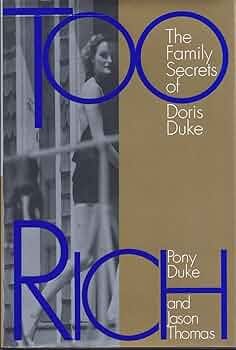The American billionaire tobacco heiress, philanthropist, and socialite Doris Duke who was at one time called "the richest little girl in the world” has long fascinated me.
As a voracious reader, I’ve stumbled upon her name repeatedly in books about wealth, art, and the gilded but fractured worlds of America’s elite.
I first encountered her in passing references within biographies of mid-20th-century socialites and in books examining the grand mansions of Newport, Rhode Island. She was portrayed as elusive, eccentric, and unpredictable—a woman of immense wealth who never quite fit the mold of the idle heiress.
This fragmented picture led me to two detailed accounts of her life: Sallie Bingham’s The Silver Swan: In Search of Doris Duke and Jason Thomas and Pony Duke’s Too Rich: The Family Secrets of Doris Duke. Together, these books paint a portrait of a woman who was at once deeply troubled and fiercely independent, a cultural rebel long before the term was fashionable.
A Life in the Crosshairs of Privilege and Rebellion
Doris Duke was born in 1912, the only child of James Buchanan Duke, a tobacco magnate who left her an inheritance of $80 million—an astronomical sum at the time.
By the time of her death in 1993, she had amassed a fortune valued at over $1 billion, making her one of the wealthiest women in the world. Yet Duke was not a figure who embraced her wealth passively. She wielded it as both a shield and a sword, funding a life of exploration, experimentation, and, often, controversy.
Duke was fiercely creative and adventurous. She was a world traveler, an astute art collector, and a patron of Islamic architecture whose restoration of the Taj Mahal’s marble floors remains a point of international acclaim.
She also defied societal norms, marrying twice (both times to men she scandalously pursued rather than the other way around) and carrying on numerous affairs. In a society that expected wealthy women to play quiet, subservient roles, Duke was bold, contrarian, and unapologetically independent.
Her wealth gave her access to some of the most influential figures of her time. Duke entertained everyone from political leaders to Hollywood stars and literary icons. She counted among her friends Greta Garbo and Jacqueline Kennedy Onassis, both women who, like Duke, operated on the blurred line between public fascination and intense privacy.
However, her relationships were often tumultuous, including with her staff, some of whom later accused her of abuse and capricious cruelty.
Why Doris Duke Still Fascinates Me
I’m drawn to Doris Duke not just for the wealth she inherited but for the ways she used it to defy expectations. Unlike many heiresses who were content to appear at society balls and occasionally fund a museum wing, Duke saw her fortune as a tool for self-expression.
Her rebellious streak—whether evidenced in her open love affairs, her passion for surfing (unusual for women of her time), or her preservation of Islamic art and architecture—speaks to a kind of fearlessness that is rare among the wealthy.
In her later years, however, this audacity came at a cost. Allegations of paranoia, manipulation, and erratic behavior plagued her life, and her highly publicized legal battles over her estate left a cloud over her legacy. These contradictions are what make her so compelling: she was a woman of extraordinary power who never seemed to find personal peace.
Reviewing the Books: Two Sides of the Same Coin
Sallie Bingham’s biography of Duke called “The Silver Swan,” is as much a reflection of the author’s fascination with her subject as it is a straightforward account of Duke’s life. Bingham approaches Duke as an enigma, trying to untangle the complexities of a woman who resisted definition.
What I appreciate about this book is its attention to Duke’s creative side. Bingham explores Duke’s work as a philanthropist, particularly her contributions to the arts and environmental preservation.
The book doesn’t shy away from Duke’s flaws—her temper, her struggles with trust, and her sometimes destructive relationships—but it frames these as part of the broader tapestry of a complicated life.
Bingham’s writing is lush and evocative, though at times it feels overly speculative. She delves deeply into Duke’s motivations, often projecting her own interpretations onto a woman who remained famously private.
Still, The Silver Swan offers a nuanced portrait of Duke as more than just a wealthy eccentric; it reveals her as a restless, searching soul who sought meaning in a world that offered her every material comfort but little emotional fulfillment.
Too Rich is a very different beast. Co-written by Pony Duke, a distant relative, and Jason Thomas, this book delves into the darker side of Doris Duke’s life. It is filled with sensational anecdotes and allegations, including accusations of emotional abuse and even foul play surrounding the mysterious death of Duke’s confidante and designer, Eduardo Tirella, who was crushed under her car in 1966.
Where The Silver Swan is literary and introspective, Too Rich is tabloid-esque and scandal-driven. It paints Duke as a woman who, despite her immense privilege, was deeply lonely and paranoid, lashing out at those around her. While this book lacks the nuance and empathy of Bingham’s work, it provides a counterpoint by exposing the ways in which Duke’s wealth may have isolated and even corrupted her.
Though less elegant in its prose, Too Rich offers valuable insights into Duke’s relationships with those closest to her, particularly the staff who bore the brunt of her volatile personality. To me, it felt like a harsher, less forgiving portrait, but one that feels necessary to balance the more romanticized narratives of her life.
A Modern Comparison
Doris Duke’s life invites comparisons to some of today’s most enigmatic and powerful women. Figures like MacKenzie Scott, who has used her divorce settlement from Amazon titan Jeff Bezos to fund transformative philanthropy, or Madonna, who has similarly courted both adoration and controversy, come to mind.
Duke’s rebellious spirit also aligns with the late Gloria Vanderbilt, another heiress-turned-artist who refused to conform to societal expectations.
But perhaps the most fitting contemporary parallel is Kim Kardashian. Like Duke, Kardashian has leveraged her wealth and notoriety to craft a unique public persona while navigating constant scrutiny. Both women represent the complexities of living in the public eye while wielding enormous cultural influence.
Doris Duke’s life defies easy categorization. She was at once a patron of beauty and a perpetrator of cruelty, a cultural visionary and a woman trapped by her own wealth.
Reading The Silver Swan and Too Rich side by side reveals the paradox of Duke’s existence, namely, that she was a woman who lived extravagantly but never seemed to find fulfillment.
In exploring Duke’s life, I’ve come to see her as a cautionary tale and an inspiration. She reminds us that wealth and privilege are no guarantees of happiness but also that they can be tools for creative expression and rebellion against societal norms. Doris Duke danced to her own tune—sometimes beautifully, sometimes chaotically—but always on her own terms.
💥 Please contribute to my independent writing journey via the “subscribe” button above . Or you can tip me some coffeehouse love here ( I am a dirty chai fan ).
Your support is appreciated! In the meantime, stay thirsty for a great book.
Diamond-Michael
Independent Journalist and Global Book Ambassador






